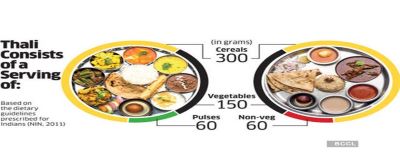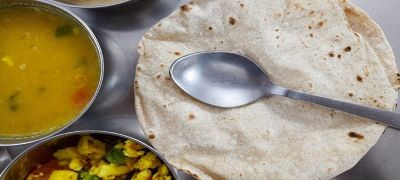Curtsy to the print
Context
Despite a decline in poverty rates and rising incomes over the past decade, India has faced challenges in significantly improving its nutritional outcomes. The National Family Health Surveys (NFHS) from 2015-16 and 2019-21 reveal persistently high levels of undernutrition among children and increasing rates of anemia among adults. Simultaneously, the prevalence of obesity and overweight has also risen in both rural and urban areas.
Overview
- As per the National institute for health, around 29⋅9 % of females are stunted, whereas the prevalence of stunting among male adolescents is 25⋅4 %. The prevalence of anemia among females is 39⋅6 % compared with 17⋅7 % among males.
- Healthy and nutritious diets are crucial for tackling the "triple burden of malnutrition"—undernutrition, overnutrition, and micronutrient deficiencies—in India. However, many Indians lack access to these diets, primarily due to the rising costs of nutritious foods like vegetables, fruits, pulses, and eggs. With real wages stagnating or declining, healthy diets are becoming increasingly unaffordable. According to the 2024 State of Food Security and Nutrition in the World report, 55.6% of India’s population (around 788 million people) could not afford a diet that meets their nutritional needs in 2022.
What is a healthy diet:
A healthy or balanced diet supplies the body with all necessary nutrients in appropriate amounts, along with adequate water and fiber. Such a diet can reduce the risk of disease and enhance overall well-being. For example, Fats, Protein, Carbohydrates, Fibre, Vitamins, and Minerals. But rising prices of food has become a challenge for a healthy and notorious food for common people.

The Issue with Thalinomics
- The cost of a thali has become a popular metric for assessing meal prices, particularly for low-income groups. In the 2019-20 Economic Survey, a chapter on "Thalinomics" calculated the cost of "typical" thalis, which include staples like rice and wheat, a mix of pulses (for vegetarian thalis) or animal-source protein (for non-vegetarian thalis), vegetables, oils, and spices, based on the 2011 Food-Based Dietary Guidelines (FBDGs) from the Indian Council of Medical Research-National Institute of Nutrition (ICMR-NIN).
- However, the thali fails to adequately reflect nutritional recommendations. Its primary components account for only about 61% of the recommended daily intake of various foods and 65% of the caloric guidelines set by NIN in 2021, while omitting several nutrient-rich food groups such as green leafy vegetables, dairy, and nuts and seeds. Additionally, Thalinomics relies on outdated data from a 2011-12 National Sample Survey of Consumer Expenditure (NSS-CES) to establish food quantities. While it may represent "typical" meals, this classification is artificial and arbitrary, given the wide variety of tastes and local food availability.
An Alternative Approach
- Track the cost of a healthy diet: Propose that the Indian government track the cost of a healthy diet (CoHD) as a standard measure for assessing the expense of meeting nutritional needs. The CoHD reflects the minimum daily expenditure required per person to fulfill energy recommendations from national Food-Based Dietary Guidelines (FBDGs), assuming all food is purchased from the market. The argument is based on three key points: first, the CoHD uses readily available price data, avoiding reliance on costly household consumption surveys like those used in calculating thali costs. Second, the calculations are straightforward and can be easily automated. Third, and most importantly, the CoHD captures different information than the cost of a thali.
- Establishing Regular Price Monitoring: Create a systematic framework to track food prices in both urban and rural areas, ensuring real-time data collection from markets.
- Leveraging Administrative Data: Utilize existing administrative data sources to obtain food prices, minimizing reliance on expensive household consumption surveys.
- Developing a Standardized CoHD Framework: Formulate a standardized method for calculating the cost of healthy diets that aligns with national Food-Based Dietary Guidelines (FBDGs).
- Incorporating Regional Variability: Adjust CoHD calculations to reflect local food availability and dietary preferences, accounting for regional differences.
- Automating Data Collection and Analysis: Employ technology to streamline data collection and analysis, enhancing efficiency and accuracy in tracking food prices and diet costs.
- Collaborating with Research Institutions: Work with universities and research organizations to refine methodologies and bolster data credibility.
- Launching Public Awareness Campaigns: Educate the public on the significance of healthy diets and their associated costs, encouraging community involvement in nutritional planning.
- Adjusting for Seasonal Price Changes: Frequently update the CoHD to account for seasonal variations in food prices, ensuring its continued relevance and accuracy.
- Advocating for Policy Support: Promote policies that subsidize nutritious foods, making healthy diets more accessible to the population.
- Conducting Regular Methodology Reviews: Carry out periodic assessments of the CoHD methodology to ensure it remains aligned with evolving dietary recommendations and economic conditions.
Conclusion
while thalis are intuitive, they do not accurately represent the true cost of nutritious diets and may even underestimate them, especially in crisis situations. Our alternative measures are not only feasible but essential, as they comprehensively reflect nutrition guidelines, avoid the need for expensive household data collection, and more accurately account for short-term price fluctuations in perishable nutritious foods.
|
Probable questions for upsc mains examination 1. Analyze the impact of rising food prices on Thalinomics and its implications for food security in India. 250 words (15 marks) 2. Discuss the effects of rising food prices on the overall economy and the living standards of the poor in India. 150 words (10 marks) |
Source: The Hindu







